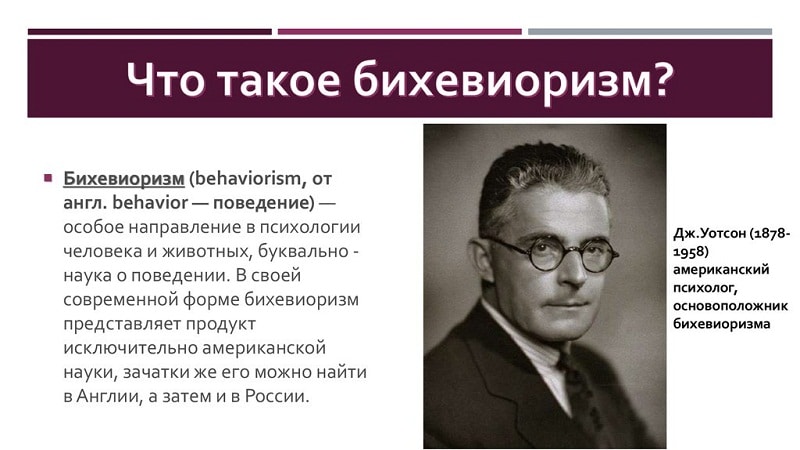What is behaviorism, who is the founder
Behaviorism in psychology is a direction that absolutely denies the existence of consciousness as an independent phenomenon. In this direction, consciousness is equated with the behavioral reactions of a person to the action of external stimuli. If we put aside psychological terms, then we can say that this direction correlates the emotions and thoughts of a person with motor reflexes, which are developed through life experience. At the beginning of the twentieth century, the emergence of this theory made a real revolution in the scientific world. In this article we will consider the main provisions of this doctrine, its advantages and disadvantages.
Behaviorism in a broad sense is a direction in psychology that studies human behavior and ways to influence human behavior.
Behaviorism is one of the psychological directions based on the study of the behavioral model of people and representatives of the animal world. The term "behaviorism" literally translated from English means "behavior". This revolutionary direction significantly changed the very essence of the American field of psychology. Proponents of behaviorism believe that today's understanding of the human psyche is completely wrong.
The founder of behaviorism is the American psychologist John Brodes Watson. He based his practice on the idea that psychological science does not study human consciousness, but a behavioral model. At the end of the nineteenth century, these concepts were considered as equal to each other. Based on this fact, a theory has arisen that the elimination of consciousness is equated with the elimination of the psyche.
This branch of psychology studies the relationship between the influence of external stimuli and behavioral responses.
In this science, importance is given to various incentives. A stimulus is any manifestation of an external influence on an individual. This concept includes the reactions of a person, which can be expressed in the form of emotions and ideas in response to the actions of others. The fact of the presence of subjective experiences is not denied, but it has a certain degree of dependence on the influence of external forces.
It should be noted that the cognitive branch of psychology partially refutes the dogmas of behaviorism. Despite this, many aspects of this direction are used in the modern world, in separate psychotherapeutic methods.
Reasons for the emergence of the theory
At the end of the nineteenth century, the main method of studying the human psyche was introspection. Behaviorism - was a revolutionary direction that called into question all traditional theories about the human psyche. The root cause of the emergence of behaviorism was the lack of documented facts, which are the basis of introspection.
The task of Behaviorism is the study of behavioral reactions as part of the true phenomenon of the psyche. The founder of this theory said that a person is born absolutely “pure” and questioned the fact of the existence of a thinking substance. Refuting the generally accepted concept, Watson John said that the occurrence of various reactions is associated with influence from the outside world. Because the response and stimulus can be measured, this approach quickly became highly accepted in the scientific community.
According to the creator of the theory, the correct approach to the study of behavioral reactions makes it possible not only to predict human behavior, but also to gain complete control over such reactions. In order to do this, the surrounding reality of a particular individual should be subjected to changes.
 The main method of classical behaviorism is the observation and experimental study of the reactions of the body in response to environmental influences.
The main method of classical behaviorism is the observation and experimental study of the reactions of the body in response to environmental influences. The Importance of Academician Pavlov's Research
What is behaviorism? Considering this issue, it should be mentioned that the main ideas of this direction originate in the research of Academician Pavlov. Ivan Petrovich Pavlov conducted research, as a result of which it was found that the unconditioned reflexes of living beings determine their behavior model. With the help of external influence, it is possible to create new conditioned reflexes, which makes it possible to control the behavior model.
John Watson in his own experiments, set up various experiments on newborn children. These studies have revealed three instinctive responses in infants. These include:
- manifestation of love;
- manifestation of fear;
- expression of anger.
Based on this, the scientist came to the conclusion that the remaining reflexes are a direct continuation of the primary ones. However, the process of formation of these reflexes has not been revealed. Since such experiments are not welcome in scientific circles, the founder of behaviorism did not receive proper support from others.
Experiments by Edward Thorndike
Behaviorism is based on many scientific studies from different areas of psychology. Edward Thorndike, the founder of the theory of operant behavior, which develops on the basis of errors and trials, made a significant contribution to the development of this direction. It is important to note that this researcher did not consider himself a behaviorist. In most of his experiments, he used pigeons and white rats.
The British philosopher Thomas Hobbes argued that associative reactions are the main base of intelligence. Herbert Spencer said that the intellectual development of an animal is responsible for the level of adaptability to changed living conditions. The experiments of Edward Thorndike made it possible to reveal that the nature of intelligence can be determined without direct interaction with consciousness. In his opinion, there is no connection between movements and ideas. The main connection is only between movements and situations.
Unlike Watson's ideas, which are based on the fact that external impulses make a person perform various movements, the basis of Thorndike's teaching is the idea that all human behavioral reactions are interconnected with problem situations, which force the creation of a new behavioral model. According to Edward, the relationship between the concepts of "reaction" and "situation" was explained by the following formula. A problem situation is a kind of starting point, in response to which the body opposes it as a whole. This forces him to look for the most appropriate behavioral response, which leads to the emergence of a new behavior model.
This theory became the starting point for the development of behaviorism. It should be noted that in Thorndike's research, those concepts were used that were later completely deleted from the new direction of psychology. Edward's idea was that the basis of behavior is the feeling of discomfort and pleasure. And in behaviorism, the very appeal to feelings and physiological factors is prohibited.
 The mission of behaviorism is to translate the speculative fantasies of the humanities into the language of scientific observation
The mission of behaviorism is to translate the speculative fantasies of the humanities into the language of scientific observation Key points
Behaviorism, as a scientific direction, is based on several provisions put forward by the author of the idea of denying the existence of consciousness as an independent phenomenon. This direction studies behavioral reactions and models of all creatures inhabiting our planet. The task of behaviorism is to study such manifestations with the help of observation.
According to the adherents of this direction, all mental and physiological aspects associated with human existence are closely interconnected with behavior. The behavior itself is considered as a set of motor reactions with the influence of external stimuli, which are designated as a stimulus. Based on these observations and knowing the nature of the external influence, the researcher is able to predict human behavior. The task of behaviorism is to teach correct predictions of human actions. With this skill, a person gains the ability to control the behavior of others.
This practice was based on the idea that all motor reactions can be divided into two groups:
- Conditioned reflexes that have an acquired character.
- Unconditioned reflexes, transmitted through the hereditary line.
Thus, human behavior is the result of a learning process in which a behavioral response, through constant repetition, becomes automatic. During the conversion process, the reactions are fixed in memory, in order to later be played back automatically. Based on this fact, it was suggested that conditioned reflexes are responsible for the formation of skills. According to Watson, thinking and speech are skills, and memory is the mechanism responsible for retaining acquired skills.
Mental reactions develop throughout human life, and to a certain extent depend on the surrounding world. The social environment, ecology, living conditions and many other factors influence human development. Also, according to the scientist, there are no specific periods that affect the development of the psyche. Watson said that there are no regularities in the formation of the child's psyche in different age periods. And the manifestation of emotions should be understood as the reaction of the whole organism to the impact of external stimuli that have a negative or positive color.
 Behaviorism became the ancestor of the behavioral approach in practical psychology, where the focus of the psychologist is human behavior
Behaviorism became the ancestor of the behavioral approach in practical psychology, where the focus of the psychologist is human behavior Advantages and disadvantages of the theory
Behaviorism is a direction in psychology, which, like all well-known practices, has its drawbacks and advantages. At the beginning of the twentieth century, this direction was considered progressive and revolutionary. But modern scientists have refuted all the postulates of this doctrine. Let's take a closer look at the pros and cons of behaviorism.
The task of this direction is to study the behavioral model of a person. For the twentieth century, such an approach to psychology was progressive, since scientists of that time studied the human consciousness, tearing it away from the outside world. The disadvantage of this teaching is that behaviorism considers the situation from only one point of view, ignoring the fact that human consciousness is an independent phenomenon.
Thanks to the followers of this trend, the issue of an objective study of human psychology has become acute. The disadvantage of the method was only that the behavior of living beings was considered only in the aspect of external manifestations. Those processes that did not lie on the surface were simply ignored by researchers. According to proponents of the theory, human behavior can be adjusted based on the practical needs of the researcher. But the mechanical approach to the question of behavioral responses reduced everything to a simple combination of primitive responses. At the same time, the very essence of the individual was completely ignored.
Representatives of this direction made laboratory experiments a kind of foundation for the psychological direction, introducing various experiments into practice. It is important to pay attention to the fact that scientists did not take into account the difference between the behavior of an animal and a person. Also, during the study of the mechanism for creating conditioned reflexes, important factors were not taken into account. These factors include: the social environment, mental image and motivation, which are the basis for the realization of the personality.
 In simple terms, the theory is that all the feelings and thoughts of a person come down to his motor reflexes, which are developed throughout life.
In simple terms, the theory is that all the feelings and thoughts of a person come down to his motor reflexes, which are developed throughout life. Followers of John Watson
John Watson, who is the founding father of the behavioral doctrine, created only the basis for this direction. But only thanks to his followers, this direction has become so widespread. Many representatives of this branch of psychology conducted quite interesting experiments.
William Hunter, in 1914, identified delayed behavioral responses. During his experiment, he showed the monkey two boxes, one of which contained a banana. After that, he closed the boxes with a screen, and after a few seconds he removed it. After that, the monkey unmistakably found the box where the banana was located. This experience proved that animals have the ability to show both immediate and delayed reactions to external stimuli.
Carl Lashley, in his experiments, was engaged in the development of certain skills in animals. After the reflex was fixed, certain brain centers were removed from the animal in order to find a connection between them and the developed reflexes. This experiment helped to determine that each brain region can successfully replace the other, since it is equivalent.



